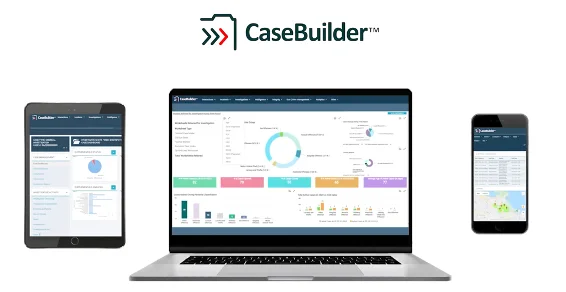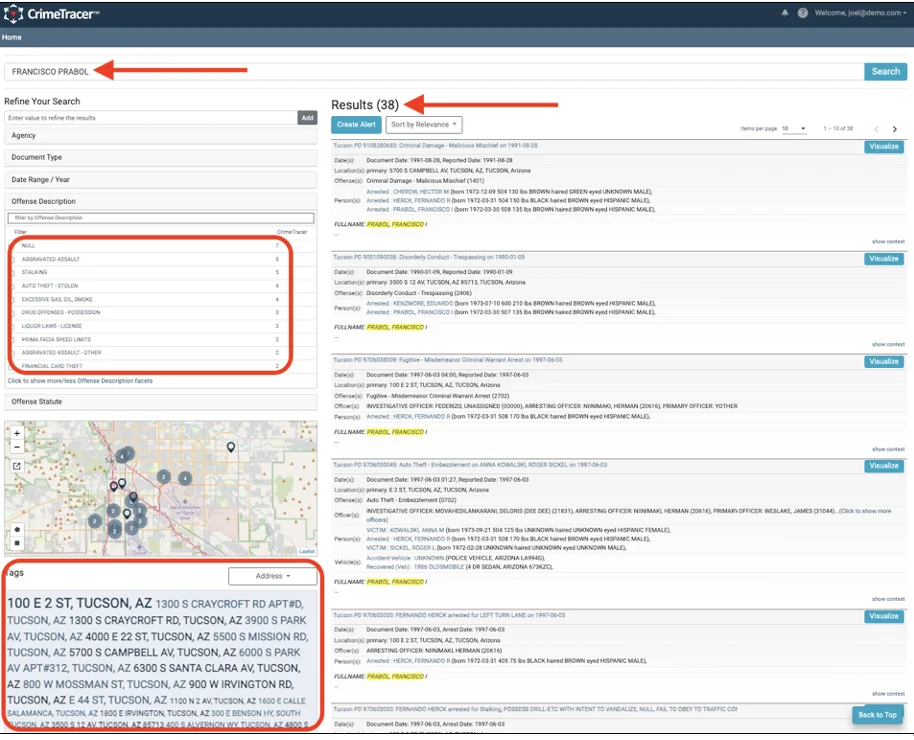Before there’s an investigation, there’s a crime. Before a crime, there’s often signs of criminal activity or intent. These signs have the potential to generate tips from concerned citizens. Tips form an early starting point for investigators and present the opportunity to be proactive and prevent crimes from ever occurring in the first place, but only if law enforcement can properly manage the information.
How can law enforcement efficiently capture tips to better inform the operational and investigative process? In this post, we’ll examine the importance of criminal intelligence database software and four key features your software must have.
Most law enforcement agencies have some form of RMS to record and track incidents and investigations. But what about the steps that occur before the crime is reported? What if police could leverage intelligence ahead of criminal activity, preventing the crime itself? The good news is that, today, agencies can implement a criminal intelligence database software to do just that.
The idea of managing an intelligence database is a critical step in policing that’s often misconstrued and under-utilized for several reasons:
- The Who: We have no budget for an intelligence unit, so who’s going to do the work?
- The What: What does formal intelligence management entail?
- The How: How do we maintain compliance with the regulations?
- The Why: We’ve never used software before, so why now?
But intelligence is nothing more than simply gathering information, analyzing it and leveraging it appropriately. Even small law enforcement agencies can benefit from intelligence without having to staff an entire unit or hire an intelligence analyst.
What you need to get started is a secure criminal intelligence management software, some training so intelligence gathering does not overstep its bounds and a culture shift that prioritizes collaboration, communication, and a willingness to try different policing methods to reduce crime.
The Importance of Intelligence Tracking
Intelligence tracking is the behind-the-scenes work that feeds a law enforcement agency’s investigative process and directs operations and deployment of resources.
The purpose of intelligence tracking is to find connections between criminal activity or intentions and people, or places, stored in your criminal intelligence database software.
While suspicious activity is not always criminal, it helps inform decision-making and determine the next steps in an inquiry. With intelligence tracking, police officers that monitor gang activity or gather tips from confidential informants can more efficiently connect the dots between suspicious activity, known criminals, crime locations, and the likelihood of future crimes. This makes the agency more efficient when cracking down on crime.
For example, if a law enforcement agency tracking a violent criminal gang recognizes a sudden up-tick in assaults on the incident side of their operations, they can turn to their intelligence database to see if and how the increase in assaults connects to that particular gang. They can search the people involved (including victims and suspects), the activity locations, and the method of operation and see if there are any links back to the gang. If links are established, they might set up surveillance on gang members or utilize a reliable confidential informant to provide information that ultimately leads to the arrest and prevents future assaults.
Still, while this type of data storage and tracking can make a department more efficient – it can also create compliance headaches, which sometimes present a roadblock for agency intelligence efforts. But this is true only if you have the wrong kind of database that doesn’t ensure compliance.
Scrapping Non-Compliant Intelligence Databases
Over the past few years, we’ve seen several headlines about law enforcement agencies with outdated, poorly managed databases that had to scrap the entire system and start from scratch because of non-compliance. Oftentimes, these databases are homegrown solutions that haven’t been regularly reviewed and updated.
Los Angeles – often considered the Gang Capital of America – has an estimated 45,000 gang members in the city. In 2012, advocates pushed to reform the database the LAPD used due to its inaccuracy. By 2018, the database shrunk to about 100,000 names for the entire state of California – a significant cut to the LAPD’s intelligence resource.
So, why was the database inaccurate in the first place?
Because there wasn’t an efficient way to review and purge outdated or irrelevant data. If a gang member was in the database but disassociated from the gang, the database didn’t update to reflect the change. This meant that person could be unjustly profiled for suspicious activity, creating a significant civil liberties issue.
So, what’s the solution? How can law enforcement gather actionable intelligence that helps counteract threats, follow up on tips, and crack down on gang activity – all while remaining compliant? It’s actually pretty simple. They need the right criminal intelligence database software. Let’s take a look at what that means.
Criminal Intelligence Database Software: 4 Essentials
A raw list of people and places is not intelligence. This is why it’s important to have actionable, criminal intelligence database software that helps transform the data into actionable analytics. Here’s what your intelligence software should be able to help you do:
1. Protect Confidential Informants
Confidential informants (CIs) are critical to the intelligence process. As defined by the Department of Justice, a CI is “any individual who provides useful and credible information to a Department of Justice Law Enforcement Agency (JLEA) regarding criminal activities, and from whom the JLEA expects or intends to obtain additional useful and credible information regarding such activities in the future.”
Most confidential informants risk their lives to help law enforcement. Your criminal intelligence database software must be able to track and protect them. This means registering them, tracking the tips and leads they provide, rating their reliability for future use, and protecting their identity. All in one secure, compliant system.
CIs are invaluable to law enforcement agencies. Careless management of their information can have dire consequences for your agency, your cases, and the CI’s life.
2. Review Gang Members & Criminal Organization Activity
A core function of most intelligence databases is gang- and organized crime-related records-keeping. It’s common practice to keep tabs on known members of criminal organizations, who are the source of a significant amount of criminal activity.
The right criminal intelligence database software will help you register criminal enterprises such as street gangs and organized crime groups and monitor member activities efficiently and securely. It should incorporate a process where probable cause is established, documented and reviewed prior to registering any group as a criminal enterprise. It should also follow a similar process to establish that any given person is actually an active member of the criminal enterprise.
Once a gang is established and its members are confirmed, the system should allow you to complete advanced searches, streamlining the process for background investigations and increasing your ability to produce link charts that connect the dots between people, phone records, casework and investigative leads.
3. Maintain 28 CFR Part 23 Compliance
The benefits of tracking intelligence can only be realized and accepted if your software is 28 CFR Part 23 Compliant.
Tracking, reviewing, and purging outdated intelligence and gang member data is a complex and burdensome process. Good criminal intelligence database software automates this process – reducing the administrative burden on your officers and increasing their ability to make meaningful connections.
Gangs and members must be reviewed periodically to ascertain if there is probable cause to continue maintaining the data. The same applies to other forms of intelligence – each must be periodically reviewed to verify they are indeed still accurate and of value. If reasonable cause to retain the data cannot be firmly established and approved by a supervisor, the records must be purged from the database.
Agencies should also develop or adopt standardized definitions and criteria for gang membership. These must be reasonable and justifiable. Agencies may consider adopting statutory definitions of the National Crime Information Center (NCIC) Violent Gang and Terrorist Organization File (VGTOF) to help standardize criteria.
The right software will also make it possible to mark intelligence-related documents with security classifications and restrict access and dissemination rights to users with appropriate clearance. This helps to ensure operational security while also protecting persons from unconstitutional disclosure.
These features will help ensure that you are under 28 CFR Part 23 compliance and promote secure information collection, rating of information value, periodic review and routing for quick follow-up.
4. Connect with Your Investigative Case Management Software
To enhance the positive impact of the first three features, your intelligence software should integrate with your investigative case management software.
If you can’t easily transfer valuable intelligence to the criminal investigation side of operations, then your intelligence arm isn’t properly serving its purpose or your overall agency mission.
Criminal intelligence database software isn’t about pulling data for the sake of having it. It’s less about what users see, and more about what makes the data usable.
It’s about the role-based security and access permissions that are built into it. And when it’s connected to your investigative processes, it’s more effective.
Including the intelligence software in your law enforcement agency’s enterprise-wide case management will remove information silos and help you better capture, organize and store data. Ultimately, it will elevate your investigative team’s ability to connect more dots, close more cases and increase solvability.
See how the intelligence and investigative functions can work together to keep communities safer by learning more about CaseBuilder™.





